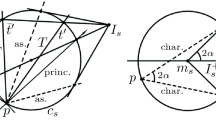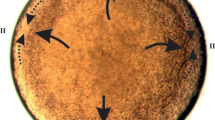Abstract
We have developed a geometric model for helical forms of consecutive phyllotaxis on the basis of an axiomatic approach. It follows from the model that rudiment growth and the movement of the cylindrical rudiment surface in the absence of a displacement in the direction along the rudiment axis leads to a repeating transition of tetragonal packaging of the rudiment into hexagonal packaging and vice versa. Under these conditions, sequences of rudiments produce left-handed and right-handed helices, the number of which at the circumference of the cylinder corresponds to adjacent numbers of the Fibonacci series. We demonstrate that the left-handed and right-handed isomers of helical forms of the consecutive phyllotaxis appear as a result of the transition of an unstable symmetric structure of the embryo at early developmental stages into stable left-handed or right-handed structures.
Similar content being viewed by others
REFERENCES
Adler, I., A Model of Contact Pressure in Phyllotaxis, J.Theor. Biol., 1974, vol. 45, pp. 1–79.
Adler, I., A Model of Space Filling in Phyllotaxis, J. Theor. Biol., 1975, vol. 53, pp. 435–444.
Adler, I., The Consequences of Contact Pressue in Phyllotaxis, J. Theor. Biol., 1977, vol. 65, pp. 29–77.
Fedorov, A.A., Kirpichnikov, M.E., and Artyushenko, Z.T., Atlas po opisatel'noi morfologii vysshikh rastenii. List (Atlas on Descriptive Morphology of Higher Plants. The Leaf), Moscow: Izd. Akad. Nauk, 1956.
Jean, R.V., Phyllotaxis, Cambridge: Univ. Press, 1994.
Kuperman, F.M., Physiology of Development, Growth, and Organogenesis in Wheat, in Fiziologiya sel'skokhozyastvennykh rastenii (Physiology of Agricultural Plants), Moscow: Izd. Mosk. Univer., 1969a, vol. 4, pp. 7–193.
Kuperman, F.M., Physiology of Wheat Resistance, in Fiziologiya sel'skokhozyastvennykh rastenii (Physiology of Agricultural Plants), Moscow: Izd. Mosk. Univer., 1969b, vol. 4, pp. 401–490.
Malygin, A.G., Structural Theory of Phyllotaxis. I. Mechanisms of Formation of Helical Structures of Consecutive Phyllotaxis, Biofizika, 1998, vol. 43, pp. 335–342.
Potapov, N.G., Mineral Nutrition of the Wheat, in Fiziologiya sel'skokhozyastvennykh rastenii (Physiology of Agricultural Plants), Moscow: Izd. Mosk. Univer., 1969, vol. 4, pp. 242–292.
Urmantsev, Yu.A., The Golden Section, Priroda, 1968, no.11, pp. 33–40.
Author information
Authors and Affiliations
Rights and permissions
About this article
Cite this article
Malygin, A.G. Theory of Phyllotaxis. I. A Geometric Model for Helical Forms of Consecutive Phyllotaxis. Russian Journal of Developmental Biology 32, 328–334 (2001). https://doi.org/10.1023/A:1012316819525
Issue Date:
DOI: https://doi.org/10.1023/A:1012316819525




